Home>Instruments>Guitar>How To Learn Songs On Guitar


Guitar
How To Learn Songs On Guitar
Published: February 13, 2024
Learn how to play your favorite songs on guitar with our step-by-step tutorials and tips. Master the guitar and impress your friends with your skills. Start learning today!
(Many of the links in this article redirect to a specific reviewed product. Your purchase of these products through affiliate links helps to generate commission for AudioLover.com, at no extra cost. Learn more)
Table of Contents
Introduction
Learning to play songs on the guitar is a fulfilling and rewarding journey that allows you to express your creativity and connect with the music on a deeper level. Whether you're a beginner or an experienced player, mastering songs on the guitar involves a combination of technical skill, musical understanding, and dedicated practice. In this comprehensive guide, we will explore the step-by-step process of learning songs on the guitar, from choosing the right song to perfecting your performance. By following these practical tips and techniques, you can enhance your guitar playing abilities and develop a repertoire of songs that resonate with your musical style.
Throughout this guide, we will delve into the fundamental aspects of learning songs on the guitar, including selecting suitable songs, understanding chords and tabs, practicing essential techniques, mastering rhythms and strumming patterns, and ultimately memorizing and perfecting the song. Each of these elements plays a crucial role in the learning process and contributes to your overall proficiency as a guitarist.
Whether you aspire to play acoustic ballads, rock anthems, blues classics, or pop hits, the principles outlined in this guide are universally applicable and adaptable to various musical genres. By embracing a methodical approach and staying committed to your practice routine, you can conquer the challenges of learning new songs and experience the joy of bringing music to life through your guitar.
Join us as we embark on this enriching journey to unravel the art of learning songs on the guitar, and let the melodious strumming of strings ignite your passion for music.
Choosing the Right Song
When embarking on the journey of learning songs on the guitar, the first crucial step is selecting the right song to master. The ideal song choice should align with your current skill level, musical preferences, and personal motivation. Here are some essential considerations to guide you in choosing the perfect song:
- Assess Your Skill Level: It’s important to be realistic about your current abilities as a guitarist. If you’re a beginner, opt for songs with simple chord progressions and basic strumming patterns. As you advance, you can gradually challenge yourself with more complex songs that incorporate intricate techniques and advanced fingerpicking.
- Identify Your Musical Style: Consider the genres and styles of music that resonate with you. Whether you’re drawn to the soulful melodies of blues, the raw energy of rock, the intimacy of folk, or the catchiness of pop, choosing a song that reflects your musical taste will keep you engaged and motivated throughout the learning process.
- Connect Emotionally: Look for songs that evoke a strong emotional connection. Whether it’s the heartfelt lyrics, captivating melody, or infectious rhythm, a song that resonates with you on a personal level will inspire dedication and perseverance as you strive to master it on the guitar.
- Consider Song Structure: Analyze the song’s structure, including its chord progression, tempo, and complexity. Starting with a song that has a clear and straightforward arrangement can build your confidence and provide a solid foundation for tackling more intricate compositions in the future.
- Seek Inspiration: Draw inspiration from your favorite guitarists and bands. Exploring the repertoire of artists who inspire you can lead to discovering songs that not only align with your skill level but also resonate deeply with your musical aspirations.
By carefully considering these factors, you can pinpoint a song that is well-suited to your current abilities and musical inclinations. The process of choosing the right song sets the stage for an enriching learning experience and paves the way for your growth as a guitarist.
Understanding Chords and Tabs
As you delve into learning a new song on the guitar, a fundamental aspect involves understanding chords and tabs. Chords form the harmonic foundation of a song, while tabs provide a visual representation of the fretboard and guide you through the specific notes and finger placements. Here’s a breakdown of these essential elements:
- Chords: A chord is a combination of three or more notes played simultaneously, creating a harmonious sound. Common chords are typically formed by placing fingers on specific frets of the guitar neck, and each chord has a unique fingering pattern. Learning a song’s chord progression involves mastering the transitions between different chords and maintaining a steady rhythm while strumming.
- Tabs (Tablature): Tabs provide a visual representation of the guitar’s fretboard, indicating the strings, frets, and finger placements for playing specific notes or chords. Unlike traditional sheet music, tabs are easier for beginners to interpret, as they offer a straightforward way to visualize where to place your fingers on the fretboard to reproduce the song’s melody, riffs, and solos.
When approaching a new song, it’s beneficial to familiarize yourself with the chords and tabs associated with the music. Here are some tips for effectively understanding and utilizing chords and tabs:
- Learn Basic Chords: Begin by mastering essential open chords such as G, C, D, E, A, and Em. These foundational chords are prevalent in countless songs and provide a solid starting point for building your chord vocabulary.
- Practice Chord Transitions: Focus on smooth transitions between chords, ensuring that each finger moves efficiently to the next position. Practicing chord changes gradually enhances your muscle memory and dexterity, enabling you to switch between chords seamlessly within a song.
- Follow Tab Instructions: When using tabs to learn melodies or riffs, pay attention to the numbers on each string, indicating the frets to press. Take note of any symbols or annotations that denote techniques such as slides, bends, hammer-ons, or pull-offs, as these nuances contribute to the song’s character.
- Utilize Online Resources: Explore online guitar tab websites and tutorials to access a vast repository of chords, tabs, and instructional videos. These resources offer valuable guidance and visual aids to support your learning process.
By comprehending the significance of chords and tabs and integrating them into your practice routine, you can effectively interpret and reproduce the musical elements of a song on the guitar, laying a solid groundwork for mastering the piece.
Practicing Techniques
Effective practice techniques are integral to honing your guitar skills and mastering songs with precision and proficiency. Implementing structured and focused practice sessions can significantly enhance your ability to learn and perform songs on the guitar. Here are key strategies to optimize your practice sessions:
- Consistent Practice Schedule: Establish a regular practice routine that aligns with your schedule and allows for dedicated time to focus on learning and refining songs. Consistency is key to gradual improvement and retention of new material.
- Break It Down: Divide the song into manageable sections, such as verses, choruses, bridges, and solos. By tackling smaller segments individually, you can concentrate on mastering each part before integrating them into the complete song.
- Focus on Weaknesses: Identify challenging passages or techniques within the song and dedicate focused practice to improve those areas. Whether it’s a complex chord transition, a fast-paced riff, or a specific strumming pattern, targeted practice on your weaknesses yields significant progress.
- Use a Metronome: Incorporate a metronome into your practice to develop a steady sense of rhythm and timing. Practicing with a metronome enhances your ability to play in sync with the song’s tempo and improves overall precision.
- Dynamic Practice Approach: Vary your practice dynamics by alternating between slow, deliberate playing for accuracy and faster tempos for building speed. Gradually increasing the tempo as you gain proficiency ensures a balanced development of your playing capabilities.
- Ear Training: Develop your ear by actively listening to the song and transcribing specific parts by ear. This enhances your musical perception and facilitates a deeper understanding of the song’s nuances, leading to more authentic and expressive performances.
- Record and Review: Utilize recording devices to capture your practice sessions and performances. Listening back to your recordings provides valuable insights into areas that require improvement and allows for objective self-assessment.
By integrating these practice techniques into your daily regimen, you can cultivate a focused and disciplined approach to learning songs on the guitar, leading to noticeable progress and heightened musical proficiency.
Learning Rhythms and Strumming Patterns
Mastering rhythms and strumming patterns is essential for bringing songs to life on the guitar, as it forms the rhythmic foundation and drives the musical momentum. Whether you’re playing acoustic ballads, rock anthems, or folk tunes, understanding and internalizing the rhythmic elements of a song is pivotal to delivering an authentic and engaging performance. Here’s how you can effectively learn and internalize rhythms and strumming patterns:
- Identify the Time Signature: Determine the time signature of the song, which denotes the number of beats in each measure. Common time signatures include 4/4 (common time), 3/4 (waltz time), and 6/8 (compound time), each influencing the rhythmic feel of the music.
- Emphasize Downstrokes and Upstrokes: Practice strumming with deliberate downstrokes and upstrokes, paying attention to the dynamics and accents within the rhythm. Experiment with variations in strumming intensity to convey the desired energy and feel of the song.
- Study Strumming Patterns: Familiarize yourself with various strumming patterns commonly used in different musical genres. Whether it’s the driving force of a straight-ahead rock pattern, the laid-back groove of a blues shuffle, or the intricate fingerstyle patterns of folk music, understanding diverse strumming techniques enriches your musical versatility.
- Internalize the Groove: Focus on internalizing the rhythmic groove of the song by tapping your foot or nodding your head to the beat while playing. Developing a strong sense of internal rhythm enhances your ability to stay in sync with the song and infuse it with a natural, infectious feel.
- Practice with a Drum Track: Utilize drum tracks or metronome accompaniment to simulate the feel of playing with a rhythm section. This helps in refining your rhythmic precision and reinforces the interaction between the guitar and percussion elements of the song.
- Experiment with Dynamics: Explore variations in dynamics and strumming intensity to convey the song’s emotional dynamics. Utilize subtle changes in strumming force and muting techniques to add depth and expression to your rendition of the song.
By immersing yourself in the rhythmic intricacies of the song and incorporating diverse strumming patterns into your practice, you can elevate your guitar playing to embody the authentic spirit and groove of the music, captivating listeners with your rhythmic prowess.
Memorizing and Perfecting the Song
As you progress in learning a song on the guitar, the final stages involve memorization and perfecting your performance to deliver a polished and compelling rendition. Achieving mastery of a song entails not only memorizing the chords, lyrics, and melodies but also infusing it with your personal expression and musical interpretation. Here are key strategies to effectively memorize and perfect the song:
- Internalize the Song Structure: Familiarize yourself with the song’s structure, including the arrangement of verses, choruses, bridges, and instrumental sections. Understanding the song’s roadmap facilitates seamless transitions between different segments and ensures a coherent performance.
- Lyric and Chord Integration: Integrate the lyrics with the corresponding chord changes to reinforce the association between the vocal melody and chord progression. This aids in memorizing the song’s lyrical content while maintaining rhythmic and harmonic consistency.
- Repetition and Recall: Engage in deliberate and repetitive practice to internalize the song’s components, allowing for effortless recall during performance. By consistently revisiting the song, you reinforce your muscle memory and mental retention of its intricate details.
- Expressive Interpretation: Infuse the song with your musical interpretation and emotional expression. Experiment with variations in dynamics, phrasing, and articulation to convey the song’s mood and narrative, adding a personal touch to your performance.
- Focus on Transitions: Pay particular attention to seamless transitions between chords, melodies, and rhythmic patterns. Smooth and fluid transitions contribute to the overall cohesiveness and fluidity of your performance.
- Performance Simulation: Practice performing the song as if presenting it to an audience, focusing on stage presence, confidence, and connection with the music. Simulating a live performance environment enhances your comfort and proficiency in delivering a captivating rendition.
- Seek Feedback: Solicit constructive feedback from peers, mentors, or fellow musicians to gain valuable insights into areas for improvement. External perspectives can offer fresh perspectives and refine your approach to perfecting the song.
By diligently applying these strategies and immersing yourself in the intricacies of the song, you can elevate your performance to a level of mastery, captivating audiences with a compelling and authentic rendition that reflects your musical prowess and dedication.
Conclusion
Congratulations on embarking on the enriching journey of learning songs on the guitar. Throughout this comprehensive guide, we’ve explored the essential steps and techniques that contribute to mastering songs with precision and artistry. From choosing the right song that resonates with your musical preferences to understanding chords, tabs, and strumming patterns, each aspect plays a pivotal role in shaping your proficiency as a guitarist.
As you progress through the stages of learning a song, remember that consistent practice, focused dedication, and a genuine passion for music are the cornerstones of your growth as a guitarist. Embrace the process of internalizing the nuances of a song, infusing it with your personal expression, and perfecting its delivery to captivate listeners with your musical prowess.
By integrating these strategies into your practice routine and approaching each song with diligence and creativity, you can elevate your guitar playing to embody the authentic spirit and groove of the music, captivating audiences with your rhythmic prowess and emotional resonance.
Ultimately, the art of learning songs on the guitar is a deeply rewarding endeavor that not only enhances your technical skills but also fosters a profound connection with the music you create. As you continue to explore new songs, experiment with diverse genres, and refine your performance, may your guitar become a vessel for artistic expression and a source of joy and fulfillment.
Embrace the melodies, rhythms, and harmonies that resonate with your soul, and let the strings of your guitar weave a tapestry of musical storytelling that inspires and uplifts both you and your audience. With dedication, perseverance, and a deep love for the craft, your journey as a guitarist will flourish, enriching your life and the lives of those who are fortunate to experience your music.











